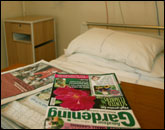by a Royal Brompton patient
As a sleep study patient, you are told to come to the Hospital at 4.30 pm, which seems a strange time to be thinking about sleep. “Come to Victoria Ward…bring night wear and toiletries,” you are told, leaving you wondering what will happen when you get there.
Well, here goes: when you arrive you will be registered as an inpatient at a desk on the ward and shown to one of four sleep laboratories, each a single bedroom. It looked to me as though for young patients an extra bed can be provided for a parent or guardian.
Your room
The room has a sink and mirror, bedside locker, table, chair, television (though mine did not have a remote control). Like all hospitals, the room is warm so you get only a sheet and blanket but you certainly only need light night wear. Two laboratories share a toilet and shower. A towel is provided but no soap etc and no floor mat.
Some medical formalities are completed by a nurse. You will have to sign an agreement with the hospital about valuables. You may be asked to swab your nose to be sure you are free of bugs like MRSA and further questioning by a doctor may also be needed depending on what you have undergone medically before this study. All this business might have taken about an hour.

Dinner is offered around 6 to 6.30 pm and the sleep technician comes at 8 to 8.30 pm to “hook” you up to some monitoring equipment. (I confess to escaping from hospital to eat at one of the many great restaurants nearby, being “allowed out” on the promise of being back by 8 pm).
There is a lounge on the ward with comfortable chairs and TV. Tea and coffee are freely available from the kitchen. All quite homely.
Getting you ready for the sleep study
A lot of information is needed to define the extent of the snoring and sleep disturbance. For this study, you will therefore have a lot of patches stuck on you with a lead from each connected to a block on a belt at your waist that is linked by a single wire to a computer.

There may be a patch on your face below the nose, the side of your head, on your chest, the sides of your trunk, your legs – these are to get information about depth of sleep, your snoring, the movements you make, whether and when you gasp for air. (I also had this study at another hospital and I think I was observed by CCTV!!). A clip on a finger will measure continuously the levels of oxygen in your blood.
Getting to sleep
You wonder how you are possibly going to sleep with all this kit on you, but from my experience (and from what the patient in the next room told me in the morning) there was not a big problem. You probably sleep no worse than you would normally in a strange bed.
You can sit on the bed and watch TV, read a book, do a crossword or sudoku without any problem and just go to sleep when you feel is a good time for you. Nurses will check on you during the night.
At around 6 am the kit will be removed and you will be left to rest until breakfast around 8 am. A doctor will see you around 9 am but by then not all the data will have been processed - so you will be asked to come to clinic for the outcome and treatment plan.
Conclusion
I hope with this personal experience you will be less anxious about the sleep study. I found all the staff on Victoria keen and willing to talk about any aspect of my study and care. If your diagnosis turns out to be sleep apnoea then there is plenty of information for you available from the staff. You can also read more about my experience returning to the lab after my diagnosis with sleep apnoea for a CPAP study.
Information on sleep apnoea
-
On the NHS Choices website I found a useful page on sleep apnoea.
-
On Victoria ward I saw a website address for the Sleep Apnoea Trust that I found had more information and links to other sites.
